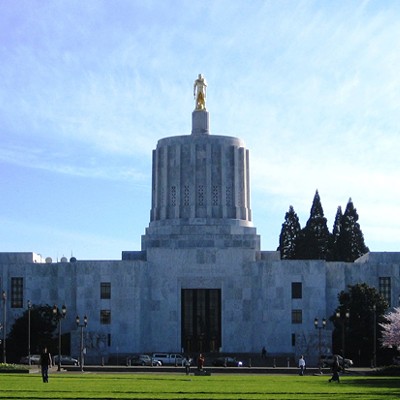With some pitiful irony, the full deterioration of John Kitzhaber's brief fourth term arrived on Friday the 13. But more painful, it was the day before Oregon's birthday. (Nope, no one in Salem was asking the governor to blow out the candles this year.)
But what is particularly odd about the rapid demise and departure from office is that Oregon has a new governor whom we didn't elect to that position. Moreover, the term "interim" is a bit misleading, as Brown will hold almost an entire two year term before the next election.
While Brown has been in Oregon politics for two decades, she has not been vetted in the way that a governor would be, with high-profile debates and editorial interviews and state-wide campaign stops. Yes, she has won back-to-back elections for Secretary of State in 2008 and 2012, but those elections rarely have the same fine-toothed scrutiny as a governor's race does—and leaves the electorate with a bit of a stranger taking the highest elected office in Oregon politics. (It is interesting to note that in her last race in 2012, she squeaked out a victory with 51 percent of the vote against Knute Buehler—and had he won that election, he would be sitting as our new governor instead of his first-term as Bend's representative in the state House.)
So, who is our new governor?
As a former House and state Senate representative from Portland, her primary base of political support is from that metropolitan region—and liberal. That said, she certainly enjoys bipartisan support from within the state capital and has roundly been lauded as easy-going, fair and friendly.
She is the second woman in Oregon's history to be governor. Barbara Roberts served one term from 1991 to 1995. Of current sitting governors, only five others—Nikki Haley (SC), Maggie Hassan (NH), Mary Fallin (OK), Susana Martinez (NM), Gina Raimondo (RI)—are women. Compared to other offices—like the U.S. Senate—this is woeful gender equity in this office, but Brown's ascension to the governor's office takes a minor step towards more balance.
Brown is also first gay or bisexual governor in America, a declaration that is far less shocking than it would have been a decade ago, at a time when Alabama probably thought hell would freeze over before allowing same-sex marriage and major league sports were still effectively closed to openly gay players.
Beyond the basic demographic information, though, Brown is certainly qualified to be the state's leader and, it is commonly believed that she was a likely and lead candidate for the 2018 governor campaign.
A Minnesota native, she attended law school in Oregon, and was first was elected to the state House in 1992. A few years later, she was elected to the state Senate, and eventually became the state's first female majority leader. Terms like "congenial" and "good natured" have been used to describe her leadership style.
There certainly will be a shift in policies and interests. While Kitzhaber pursued education and pension reforms that annoyed labor interests, Brown has strong support from public-sector unions. Over the past few years, the debate over Public Employee Retirement System (PERS) has been a common sticking point with the annual state budget, and it is likely to become an even more troublesome difference between Democrats and Republicans with Brown at the helm.
Brown's other trademark seems to be increasing access to elections through online registration, using motor vehicle registration as a means to register voters and opening up tablet technology for voters with disabilities.
But, although Brown has served for 20 years in Oregon politics, she has few hallmarks to indicate what direction she may try to take the governor's office—or exactly what it means for Oregon to have a new governor.



























